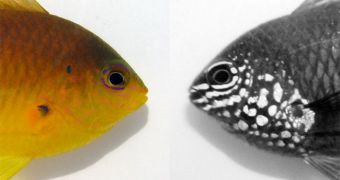Over the course of our evolution, the human brain has become very efficient at telling individuals apart from each other. We rely on facial proportions, hair styles, eyebrow length and other such factors for identifying each of the people we regularly come in contact with as individuals, but our advanced abilities are not the norm in the animal world. However, fish seem to be doing just fine, according to a new study. Investigators have determined that two species of damselfish are apt at using ultraviolet (UV) signatures to tell apart several different species of other fish, LiveScience reports.
While we, as a species, cannot perceive UV light – whose wavelength is shorter than that of visible light –, other creatures are sensitive to it. Some examples of this include certain species of butterflies and fish. While researchers knew that the marine vertebrates could see in this region of the electromagnetic spectrum, they had no idea just how advanced the animals were at using this ability. The new conclusions were drawn after the researchers, based at the University of Queensland, in Australia, set up complex experiments to gage the fish's UV-sensing abilities.
In their investigation, they collected pairs of Ambon damselfish (Pomacentrus amboinensis) and lemon damselfish (P. moluccensis), and placed them in plastic tubes. They then transported the creatures into a natural reef habitat, which was “owned” by another male Ambon damselfish. The two “intruders” were released in the waters, and the experts observed the owner's behavior. They determined that, as long as the new individuals were added in the territory under natural light, the owner of the “lands” preferred attacking fish of the same species. Some 22 out of 28 owners exhibited this trend. But this clear correlation disappeared when the investigators used UV filters above the territory. The owners attacked any of the intruders, without preference to its own kin.
“The highest level of competition is expected from members of the own species. We don’t know yet which features are used by the fish but these results show that it is possible to find systematic differences between the two species. The individual differences could code for all sorts of things that might be useful information for the fish – fitness, hierarchical status, maybe willingness to fight. We are testing this at the moment […] and so far it is looking good,” UQ expert Ulrike Siebeck says. Details of this study will appear in the March 9 issue of the respected scientific journal Current Biology.

 14 DAY TRIAL //
14 DAY TRIAL //